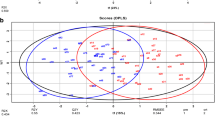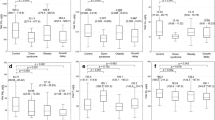Abstract
This study investigated the relationships between mineral elements and Prader-Willi syndrome (PWS) and determined which minerals, if any, separated a group of PWS individuals (N=19) from a non-PWS mentally retarded control group (N=60). The PWS group had significantly raised hair magnesium levels and significantly lower hair silicon levels than controls. The PWS group was also elevated in hair calcium, magnesium, and copper in relation to laboratory standards, while their hair silicon, chromium, and lithium levels were deficient in relation to laboratory norms. Discriminant function analysis revealed that by using 16 hair minerals subjects could be correctly classified as PWS or non-PWS with 89.5% and 95.0% accuracy, respectively. It is concluded that continuing research is needed to study the relationship between mineral element patterns and PWS.
Similar content being viewed by others
References
Adams, C. F., & Richardson, M. (1981). Nutritive value of foods (Bulletin No. 72). Washington, DC: U.S. Department of Agriculture.
Bland, J. (1979). Dietary calcium, phosphorus, and their relationship to bone formation and parathyroid activity.J. John Bastyr College Naturopathic Medicine, 1, 3–6.
Doctor's Data, Inc. (1985).Interpretation guide for trace mineral analysis. West Chicago, Il: Author.
Guthrie, H. A. (1983).Introductory nutrition. St. Louis, MO: C.V. Mosbey.
Hollingshead, A., & Redlich, F. (1985).Social class and mental illness. New York: Wiley.
Holm, V. A., & Laurnen, E. L. (1981). Prader-Willi syndrome and scoliosis.Developmental Medicine and Child Neurology, 23, 192–201.
Laker, M. (1982). On determining trace elements in men: the uses of blood and hair.Lancet, 12, 260–263.
Marlowe, M., Cossairt, A., Moon, C., & Errera, J. (1985). Main and interaction effects of metallic toxins on classroom behavior.Journal of Abnormal Child Psychology, 13, 185–198.
Marlowe, M., Errera, J., & Jacobs, J. (1983). Increased lead and cadmium levels in mentally retarded and children with borderline intelligence.American Journal of Mental Deficiency, 87, 433–437.
Marlowe, M., Folio, R., Hall, D., & Errera, J. (1982). Increased lead burdens and trace mineral status of mentally retarded children.Journal of Special Education, 16, 87–99.
Moon, C., Marlowe, M., & Errera, J. (in press). Main and interaction effects of metals on childhood intelligence. InProceedings of the 6th International Conference on Heavy Metals in the Environment. Edinburgh, United Kingdom: CEP Consultants, Ltd.
Moon, C., Marlowe, M., Stellern, J., & Errera, J. (1985). Main and interaction effects of metal toxins on cognitive functioning.Journal of Learning Disabilities, 18, 217–221.
National Academy of Sciences. (1980). Recommended dietary allowances. Washington, DC: Author.
Nie, H., Hull, C. H., Jenkins, J. G., Steinbrenner, K., & Bent, D. H. (1975).Statistical package for the social sciences. New York: McGraw-Hill.
Passwater, R. A., & Cranton, E. M. (1983).Trace elements, hair analysis, and nutrition, New Canaan, CT: Keats Publishing.
Prader-Willi Syndrome Association. (1984).Synopsis: Prader-Willi syndrome and association. Edina, MN: Author.
Pfeiffer, C. (1974). Observations on trace and toxic elements in hair and serum.Journal of Orthomolecular Psychiatry, 3, 259–264.
Phil, R., Drake, H., & Vrana, F. (1980). Hair analysis in learning and behavior problems. In E. Brown & J. Crounse (Eds.),Hair, trace elements, and human illness. New York: Praeger.
Pratt, W., & Phippen, W. (1980). Elevated hair copper levels in idopathic scoliosis.Spine, 5, 230–233.
Thatcher, R. W., Lester, M. L., McAlaster, R., & Horst, R. (1982). Effects of low levels of lead or cadmium on cognitive functioning in children.Archives of Environmental Health, 37, 159–164.
Underwood, E. J. (1977).Trace elements in human and animal nutrition. New York: Academic Press.
Venugopal, B., & Luckey, T. D. (1982).Metal toxicity in mammals (Vol. 2). New York: Plenum Press.
Author information
Authors and Affiliations
Rights and permissions
About this article
Cite this article
Marlowe, M., Medeiros, D.M., Errera, J. et al. Hair minerals and diet of Prader-Willi syndrome youth. J Autism Dev Disord 17, 365–374 (1987). https://doi.org/10.1007/BF01487066
Issue Date:
DOI: https://doi.org/10.1007/BF01487066




